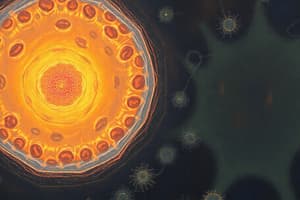Podcast
Questions and Answers
Which structure is unique to eukaryotic cells?
Which structure is unique to eukaryotic cells?
Nucleus
Which best describes mitochondrial DNA (mtDNA)?
Which best describes mitochondrial DNA (mtDNA)?
Mitochondrial DNA can be traced for generations.
What is the entire object shown in the image?
What is the entire object shown in the image?
Eukaryote
What is the basic unit of structure and function of all living organisms?
What is the basic unit of structure and function of all living organisms?
Which cell structure serves the stated function in both eukaryotic and prokaryotic cells?
Which cell structure serves the stated function in both eukaryotic and prokaryotic cells?
Based on the Endosymbiotic theory, what cell would result from the endosymbiosis of a cell with a cyanobacterium?
Based on the Endosymbiotic theory, what cell would result from the endosymbiosis of a cell with a cyanobacterium?
In which specimen were cells first identified?
In which specimen were cells first identified?
Why would removing the nucleus from a cell fail to produce a new prokaryotic cell?
Why would removing the nucleus from a cell fail to produce a new prokaryotic cell?
Which statement best describes how a cell with ribosomes in mitochondria could be classified?
Which statement best describes how a cell with ribosomes in mitochondria could be classified?
Which components are found in both prokaryotic and eukaryotic cells?
Which components are found in both prokaryotic and eukaryotic cells?
Study Notes
Cell Types and Structures
- Eukaryotic cells possess a nucleus, a unique structure that distinguishes them from prokaryotic cells.
- Prokaryotic cells lack a nucleus and are generally simpler in structure compared to eukaryotic cells.
Mitochondrial DNA
- Mitochondrial DNA (mtDNA) can be traced through generations, indicating its inheritance pattern and use in genetic studies.
Identification of Cells
- The first identification of cells was made using cork bark, showcasing early advancements in microscopy.
Basic Unit of Life
- The cell is the fundamental unit of structure and function in all living organisms, serving as the building block of life.
Cell Structures Common to Both Cell Types
- Cytoplasm serves to protect the internal structures of both eukaryotic and prokaryotic cells, providing a medium for biochemical reactions.
Endosymbiotic Theory
- The Endosymbiotic theory explains the evolution of eukaryotic cells, suggesting that they originated from symbiotic associations with prokaryotes, such as when a cell incorporates a cyanobacterium.
Genetic Information and Nucleus
- Removing the nucleus from a eukaryotic cell will not result in the creation of a prokaryotic cell because the nucleus contains essential genetic information required for cell function.
Classification of Cells
- Cells containing ribosomes in mitochondria are classified as eukaryotic due to the presence of mitochondria, an organelle associated with energy production.
Vulnerabilities in Cells
- Both prokaryotic and eukaryotic cells share critical components that can be harmed by certain chemicals, including DNA, cell membrane, cytoplasm, and ribosomes, indicating common vulnerabilities across cell types.
Studying That Suits You
Use AI to generate personalized quizzes and flashcards to suit your learning preferences.
Description
Test your knowledge on prokaryotic and eukaryotic cells with these flashcards. Each card presents a question related to the structures, functions, and characteristics of these fundamental cell types. Enhance your understanding of cellular biology through this interactive format.




